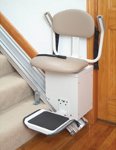A Stair Lift Primer
Published by Stephen on January 18, 2010 Under stair lifts Using the stairs is something that can be quite dangerous for seniors with limited mobility. There are a host of factors that can increase the likelihood of a fall on the stairs and numerous studies have shown that serious injuries are much more difficult to recover from for the elderly. Since of all areas in the home, most serious senior falls occur on the stairs, it is essential that the stairs can be used safely by all occupants in a home, especially the elderly. One way to make the stairs safer is to install a stair lift.
Using the stairs is something that can be quite dangerous for seniors with limited mobility. There are a host of factors that can increase the likelihood of a fall on the stairs and numerous studies have shown that serious injuries are much more difficult to recover from for the elderly. Since of all areas in the home, most serious senior falls occur on the stairs, it is essential that the stairs can be used safely by all occupants in a home, especially the elderly. One way to make the stairs safer is to install a stair lift.
Stair lifts are a type of home medical equipment that is attached to a staircase and provide a motorized system that carries the user safely up the stairs and back down again. The most common type of stair lift is the stair chair, which has a chair, usually made of plastic, that is attached to a metal track spanning the distance so the stairway. The chair moves along the track, carrying the senior safely and with little risk of a fall.
The other type of stair lift is the perch lift, which provides a small platform for the senior to stand on as they are carried up the staircase. Perch lifts, or standing stair lifts, otherwise are similar to a stair chair, in that they use a similar tracked system that is attached to the steps of the stairway. In addition to several hand rests, some perch lifts also include a small bench that can be leaned against as the safety device is in motion.
Since the senior is seated when using a stair chair, they are typically much safer than perch lifts. However, there are some cases where a perch lift might be a better choice. For example, on a very narrow staircase, there may not be enough room for a stair chair, making a perch lift the only option. Those who are recovering from a hip or knee replacement surgery might also require a perch lift, as they may not be able to safely bend their knees enough to sit down in a stair chair.
What is the Difference Between Battery Stair Lifts and AC Stair Lifts?
As the name implies, a battery stair lift is powered by a rechargeable battery, where an AC Stair lift draws its power directly from an electrical outlet. However, both types of stair lifts are plugged directly into a standard household outlet.
The main advantage of an AC Stair Lift is that it costs less than a battery stair lift, but it will not work if the home looses power. In addition to having a higher upfront cost, the battery of a batter stair lift, or DC stair lift, must also be periodically replaced, usually once every 12 to 18 months. So, there will be a higher recurring maintenance cost with a battery powered stair lift as well. However, in the event of an emergency where the home looses power, a battery powered stair lift will continue to work.
No Comments |
Add a Comment